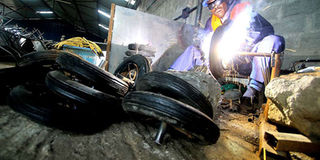EAC must not be left behind in Fourth Industrial Revolution

Wheelbarrow wheels are fabricated in a plant in Nakuru on July 28, 2016. The contribution of manufacturing to EAC economies’ GDP has been declining. PHOTO | FILE | NATION MEDIA GROUP
What you need to know:
- Industrialisation is the only sure way that EAC countries can create value jobs for their tens of millions of unemployed youth.
- There is a need to tap the comparative advantages among EAC economies to increase intra-country trade.
As the developed and emerging economies are on the cusp of the Fourth Industrial Revolution (4IR), the East African Community is, regrettably, yet to exploit the full potential of all the other three.
In matters industrialisation, the EAC is a sleeping giant.
With a population of more than 172 million and total gross domestic product (GDP) in excess of $172.7 billion (about Sh17.5 trillion), the EAC presents a huge market for manufactured goods.
Yet the region practically missed the Agricultural Revolution, is only scratching on the surface of the Industrial Revolution and does not have the infrastructure to fully exploit the Information Revolution.
Having missed the industrialisation phase, it will be a tall order for the EAC to build the capacity to catch up with leading economies in the 4IR, but it is worth the effort to try.
SUPPORT LOCAL PLANTS
Industrialisation is the only sure way that EAC countries can create value jobs for their tens of millions of unemployed youth and grow value chains that can generate wealth for generations.
This is the script the West and emerging economies such as China, India and Brazil followed and Africa is no exception.
The EAC’s exports comprise mainly unprocessed agricultural produce and commodities such as minerals and oil (for South Sudan).
Owing to its huge appetite for processed goods, the EAC has contributed a lot to the industrialisation of other places to its own detriment.
Kenya, for example, imports up to 5,000 cars a month yet its three assembly plants, which are struggling to exploit their full capacity, can produce 30,000 units a year, far exceeding the EAC’s demand.
This translates to the loss of millions of jobs and hundreds of millions of dollars in lost foreign exchange.
Intra-EAC trade data, as well as the region’s imports from China, paint a clear picture of the declining industrialisation.
Total trade among Kenya, Uganda, Tanzania, Rwanda and Burundi declined by 20 per cent to $2.12 billion (Sh212 billion) in 2012-2016, as per the East African Business Council data.
DECLINING SECTOR
But Chinese imports to the EAC amounted to $6.75 billion (about Sh683.8 billion) in 2017, more than thrice the 2009 figure.
Kenya, the region’s biggest economy, imported $3.9 billion (about Sh395 billion) goods from China in 2017 — compared to Tanzania $1.69 billion (about Sh171 billion) and Uganda $1.15 billion (about Sh116.5 billion).
Chinese goods accounted for 22 per cent of total imports to Kenya, Uganda and Tanzania in 2013-2017, an analysis by the Observatory of Economic Complexity shows.
Despite a ready market for secondary and tertiary goods, the contribution of manufacturing to EAC economies’ GDP has been declining.
Manufacturing as a percentage of GDP dropped from a high of 10.6 per cent, 9.5 per cent and 6.4 per cent in Kenya, Uganda and Tanzania, respectively, in 2013 to 8.3 per cent, 8.5 per cent and 5.5 per cent in 2017.
Decline in manufacturing takes away the region’s hopes of generating high-quality jobs for its citizenry and other support industries that buttress solid and long-term economic growth.
CLOSE PARTNERSHIPS
EAC policymakers must recalibrate the economies in readiness for the 4IR, which is technologically driven and, predictably, less capital-intensive than the industrialisation phase.
There is a need to tap the comparative advantages among EAC economies to increase intra-country trade.
The public and private sectors need to work more closely together to develop enabling policies that eliminate tariff- and non-tariff barriers that hinder large-scale industrialisation in the region.
Mr Mworia is the Group CEO, Centum Investment. @MworiaJ


